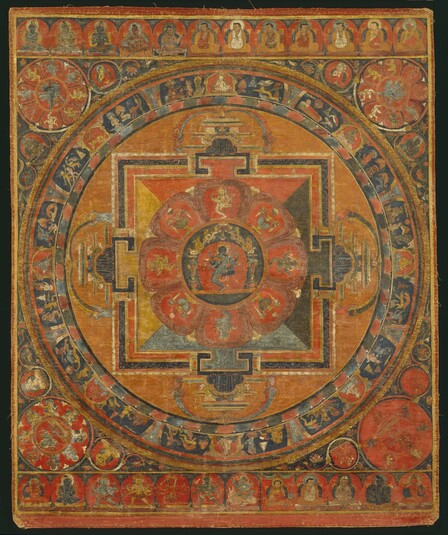
Item: Mandala of Mahamaya (Buddhist Deity)
| Origin Location | Tibet |
|---|---|
| Date Range | 1300 - 1399 |
| Lineages | Kagyu and Buddhist |
| Size | 63.50x53.34cm (25x21in) |
| Material | Ground Mineral Pigment on Cotton |
| Collection | Private |
Classification: Deity
Mahamaya, Five-deity Mandala according to the Tradition of Mahasiddha Kukkuripa and the lineage of Ngogton Lotsawa.
Mahamaya, meaning 'great illusion,' is the name of a Tantric Buddhist Sanskrit text, the Shri Mahamaya Tantraraja, and the name of a deity and meditation system. The text was popularized in India between the 9th and 11th centuries and is most commonly associated with the mahasiddha Kukkuripa known as the 'dog lover' and the Tibetan translator Marpa Chokyi Lodro, famed teacher of the great yogi Milarepa. The Mahamaya Tantra and practices arrived in the Himalayas and Tibet through a number of different sources but primarily through the Vajravali literature of Abhayakaragupta, Marpa the translator, the Mitra Gyatsa of Mitra Yogin and the Shangpa Kagyu Tradition. Mahamaya is regarded as a special deity of the Ngog lineage of the Marpa Kagyu. Within the Shangpa Kagyu Mahamaya is included as one of Five Tantra Deities (gyu de lha nga) combined as a single and unique meditation practice found only in the Shangpa Tradition.
In art and tantric visualization Mahamaya is depicted with four faces and four arms, blue in colour, embracing the consort Buddha Dakini. She also appears with four faces and four arms. Both figures hold an arrow, bow, skullcup and katvanga staff. In the Shangpa Kagyu, Vajravali and Mitra Gyatsa traditions the consort can also be depicted as red in colour. In the Mitra Gyatsa there is a one faced two-armed form of Mahamaya with consort. In all of these different traditions the central deity and consort are accompanied by four attendant retinue figures called dakini; blue Vajra Dakini (east), yellow Ratna Dakini (south), red Padma Dakini (west) and green Vishva Dakini (north). Placed between the dakinis at the intermediate directions are four nectar filled vases. From the central couple and the four retinue figures we get the official name Mahamaya Five Deity Mandala. It is common in the descriptions of Buddhist mandalas to count the central couple as one deity, although not a rule and not always consistent. The retinue and attendant deities are then counted individually although in many instances the door guardians are omitted in the final total.
"Mahamaya, blue, with four faces, blue, yellow, red, green. The first two hands hold a skullcup and katvanga staff while embracing the consort. The lower two [hands] hold an arrow and bow. Standing with the left leg drawn up in a half posture dancing manner. Wearing a human skin upper garment. The consort, Buddha Dakini, is red, the same [in appearance], embracing, with a crown of dry skulls, head necklace and five mudra [ornaments]." (bod brgyud nang bstan lha tshogs chen mo bzhugs so, 2001. ISBN 7-5420-0816-1. Page 380-383).
Aside from the Vajravali lineage of Abhayakaragupta and the Mitra Yogin lineage there are several lineages from India that were passed through Marpa Lotsawa. Lineage 1: Vajradhara, Nagarjuna, Aryadeva, Tilopa, Naropa, Marpa Chokyi Lodro, Ngog Choku Dorje, Shedang Dorje, etc. Lineage 2: Vajradhara, Kukkuripa, Padmavajra, Tilopa, Naropa, etc. Lineage 3: Vajradhara, Vajrapani, Nagarjuna, Aryadeva, Samantabhadra, Sumati, Gewai Gocha, Namgyal Wangpo, Marpa Chokyi Lodro, etc.
Along the top of the painting, beginning on the left side, is a register of lineage teachers beginning with the primordial Buddha Vajradhara followed by two unidentified celestial or bodhisattva-like figures. The next in line is the mahasiddha Kukkuripa holding on the right side a dog in the lap. After that there is another Indian siddha followed by the Tibetan lineage teachers in an unbroken line of transmission. It is likely that the lineage depicted in the register is that of Kukkuripa and Ngogton Choku Dorje. Beneath the register, at the upper right, is a mandala circle depicting the Essence Hevajra from the Shri Hevajra Tantra. In the upper left is another mandala circle depicting Hevajra as he is described in the Samputa Tantra. At the lower right is red Vajrayogini Varahi of the mahasiddha Indrabhuti. In the two accompanying circles are further forms of Vajrayogini popularized by the Indian adepts Maitripa and Naropa; Maitri Khechari and Naro Khechari. At the bottom left side is the mandala of the female meditational deity Jnana Dakini, blue in colour, with three faces and six hands.
The bottom register contains three Tibetan teachers, four minor peaceful deities, four wrathful deities and the female protector deity Shri Devi, blue in colour, with four arms and riding a donkey.
Tibetan name: rngog lugs ma ha ma ya (sgyu 'phrul chen mo) lha lnga'i dkyil 'khor Sanskrit source text: Shri Mahamaya Tantraraja Nama [Toh 425]
Jeff Watt 2-2009
Exhibition: Mandala, The Perfect Circle (RMA)
Thematic Sets
Buddhist Deity: Mahamaya (right leg down)
Buddhist Deity: Mahamaya (Masterworks)
Buddhist Deity: Mahamaya (Mandalas)
Buddhist Deity: Mahamaya Main Page
Mandala: Early Works (1100-1399)
Buddhist Deity: Mahamaya Iconography

